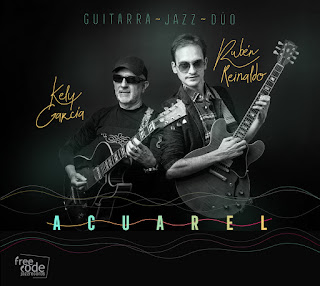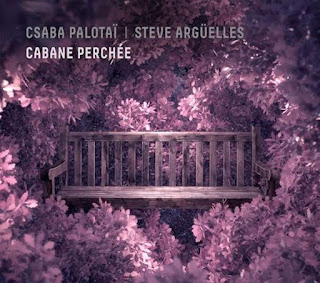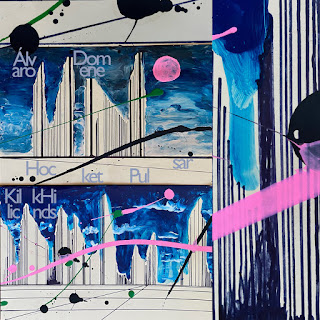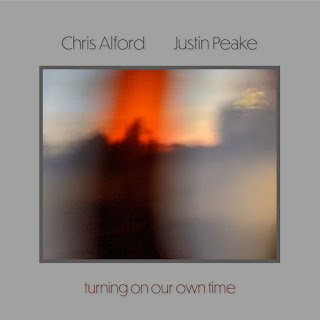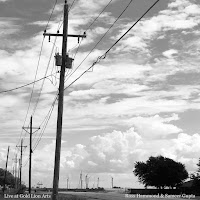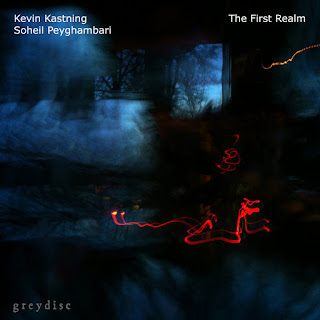By Paul Acquaro
Part two in the series of recent guitar duos, before we move onto trios. We begin today with a couple of actual guitar duos and continue from there …
Rubén Reinaldo & Kely García Guitarra Jazz Dúo – Acuarel (Free
Code Jazz Records, 2020) ****
Guitar and Guitar. I’ve confessed before about my reverence for the
guitar duo – and by this I mean simply two guitars playing together. To my simple ears,
the musical ground that a pair of guitarists, attuned to their instruments and in tune with each other, is boundless. A sensitive pair can switch
from quiet introspection to explosive outpouring effortlessly, leading the
listener almost anywhere. The duo of Rubén Reinaldo & Kely García,
two accomplished guitarists and educators from the Galician region of
Spain, are exemplars of this configuration. Hailing from different
generations, the younger Reinaldo and the established Garcia find much common
ground in navigating the tunes of Acuarel. With nods to tradition, both
musically and culturally, the two weave fluid melodic lines through rich
harmonic passages, filling the musical space generously but still leaving
plenty of room to not drown the listener. A wonderful example is the track
‘Coscovals’ – a modern jazz melody pings off a lilting comp, bright,
light, but with a depth that invites the listener to dive deep. The title
track is rhythmically alluring piece featuring an intricate interlocking
melody. The final track, ‘Berimar Blues’ takes the album out in a
blues-tinted flourish.
The duo reminds me, in some ways, of some of the exemplary guitar
collaborations festooning my collection – like Bill Frisell and Dale
Bruning, or Joe Pass and Herb Ellis, or – one of my evergreens – Vic Juris
and Bireli Lagrene (not actually a duo, but good enough), or even Julian Lage and Nels Cline – no, none of these
are truly comparable, but they all demonstrate compatibility, tunefulness,
and selflessness. Added bonus: for the guitar players out there, the
recording (even the download) comes with a book of transcriptions.
collaborations festooning my collection – like Bill Frisell and Dale
Bruning, or Joe Pass and Herb Ellis, or – one of my evergreens – Vic Juris
and Bireli Lagrene (not actually a duo, but good enough), or even Julian Lage and Nels Cline – no, none of these
are truly comparable, but they all demonstrate compatibility, tunefulness,
and selflessness. Added bonus: for the guitar players out there, the
recording (even the download) comes with a book of transcriptions.
Ivar Grydeland & Henry Kaiser – In The Arctic Dreamtime (Rune
Grammofon, 2020) ****½
Guitar and Guitar.
Apparently the product of a spontaneous decision to record,
American guitarist (and arctic explorer) Henry Kaiser met up with Norwegian
guitarist Ivar Grydeland in Oslo and made a soundtrack to the
documentary Ellsworths flyveekspedition 1925, an early silent film
about arctic explorer Roald Amundsen’s second attempt to reach the North
Pole. Less than two hours after starting, they were done, notably more
successful than Amundsen in fulfilling their mission.
Apparently the product of a spontaneous decision to record,
American guitarist (and arctic explorer) Henry Kaiser met up with Norwegian
guitarist Ivar Grydeland in Oslo and made a soundtrack to the
documentary Ellsworths flyveekspedition 1925, an early silent film
about arctic explorer Roald Amundsen’s second attempt to reach the North
Pole. Less than two hours after starting, they were done, notably more
successful than Amundsen in fulfilling their mission.
The opening track
already signals that it will be an atmospheric journey, ‘Roald Amundsen
1925’ opens with an evocative drone and blips of electric guitar. Over a
sinuous backdrop, melodic intentions build, reaching a searing altitude
around half way trough the 17+ minute track. Projected against bleakness, the guitar’s distorted buzz is electrifying and lonely, it feels very much like we’re soaring over a endless cracked icy white landscape,
listening to the fears in our heads. It is, in a sense, frighteningly
gorgeous. The track ‘Spitsbergen’ is different, arpeggios with a touch of blues, a little Morricone, and a little bit of the
musical language from Grydeland’s group Huntsville. It feels open ended,
somewhat jagged, and tempting. Each track seems to capture a similar mood
just a little differently, ‘To the North Pole’ seems a bit hopeful, ‘N-25’
a bit forlorn, and Into the Arctic Dreamtime, somewhat terrifying. Quite
an evocative recording!
already signals that it will be an atmospheric journey, ‘Roald Amundsen
1925’ opens with an evocative drone and blips of electric guitar. Over a
sinuous backdrop, melodic intentions build, reaching a searing altitude
around half way trough the 17+ minute track. Projected against bleakness, the guitar’s distorted buzz is electrifying and lonely, it feels very much like we’re soaring over a endless cracked icy white landscape,
listening to the fears in our heads. It is, in a sense, frighteningly
gorgeous. The track ‘Spitsbergen’ is different, arpeggios with a touch of blues, a little Morricone, and a little bit of the
musical language from Grydeland’s group Huntsville. It feels open ended,
somewhat jagged, and tempting. Each track seems to capture a similar mood
just a little differently, ‘To the North Pole’ seems a bit hopeful, ‘N-25’
a bit forlorn, and Into the Arctic Dreamtime, somewhat terrifying. Quite
an evocative recording!
Csaba Palotai, Steve Argüelles – Cabane Perchée (BMC, 2021) ***½
Guitar and Percussion. This recording, from a Hungarian guitarist Csaba Palotai and British drummer Steve Argüelles was a pleasant and unexpected surprise. The two musicians, collaborators living in France, have certainly built their Cabane Perchée – tree house, or as DeepL will have it, ‘perched cabin’ on some strong branches of rhythm and repetition. Through the crisp, lively recording comes clear, developed ideas that build-up thir energy through circular motifs and strong grooves. ‘Bulgarian Rhythm 1’ opens the album with a swiftly moving cluster of chords and bare bones percussion accompaniment. The full sound is somewhat surprising given the instrumentation, but it is no exception, as the second track ‘Phosphore’ shows. Again a repetitive figure from the guitar and a laser focused set of percussive devices keeps the music lively and when Palotai breaks up the figure with short melodic runs the contrast is alluring. However, just as soon as one thinks there is a pattern forming, ‘In Tents’, the third track, shakes things up. Argüelles plays a prepared acoustic guitar, giving Palotai’s acoustic guitar a much different rhythmic base to build on, which he does with slowly expanding chordal voicings, ending with an emotive solo passage. A very nice, composed, acoustic recording.
Álvaro Domene & Killick Hinds – Hocket Pulsar (Iluso, 2021) ***½
Guitar and String Instruments (and some electronics).
According
to the liner notes, it was Henry Kaiser who introduced the Georgia (USA) based
Killick Hinds and New York based Álvaro Domene based on a feeling that they
were musically compatible. His hunch proved correct as the duo quickly set
forth to create Hocket Pulsar. On first listen, one could be forgiven
thinking there is a glitch in their Bluetooth speaker connection. The
opening title track is a long, patient expansion of sound. There are
glitchy pops and fizzes of electronics over a drone for half of the track,
while a more traditional electric guitar appears now and then in the mix.
As the track evolves, the guitar takes over with rhythmic plucking of the
lower strings and other elongated tones. It takes patience, but the effect
is a rewarding experience. The next track ‘Voces Magicae’ offers a
contrast, less electronic sounds and more percussive used of stringed
instruments provide the setting. The other guitar strikes a minimalist
melody, for a bit, until it becomes goopier both acoustically and
electronically. ‘Kinesis in Unlimited Dimensions’ explores other sounds,
growls from the guitar mesh with digital spouts, while ‘Meditation on
Mediation’ takes a quieter but still very active approach, seemingly
processing the sounds of the guitar other instruments into an effective
blend. Overall a successfully experimental mélange of
acoustic/electronic/digital sounds.
According
to the liner notes, it was Henry Kaiser who introduced the Georgia (USA) based
Killick Hinds and New York based Álvaro Domene based on a feeling that they
were musically compatible. His hunch proved correct as the duo quickly set
forth to create Hocket Pulsar. On first listen, one could be forgiven
thinking there is a glitch in their Bluetooth speaker connection. The
opening title track is a long, patient expansion of sound. There are
glitchy pops and fizzes of electronics over a drone for half of the track,
while a more traditional electric guitar appears now and then in the mix.
As the track evolves, the guitar takes over with rhythmic plucking of the
lower strings and other elongated tones. It takes patience, but the effect
is a rewarding experience. The next track ‘Voces Magicae’ offers a
contrast, less electronic sounds and more percussive used of stringed
instruments provide the setting. The other guitar strikes a minimalist
melody, for a bit, until it becomes goopier both acoustically and
electronically. ‘Kinesis in Unlimited Dimensions’ explores other sounds,
growls from the guitar mesh with digital spouts, while ‘Meditation on
Mediation’ takes a quieter but still very active approach, seemingly
processing the sounds of the guitar other instruments into an effective
blend. Overall a successfully experimental mélange of
acoustic/electronic/digital sounds.
Guitar and Saxophone. Before we veer out of the electronics, let’s talk
about (virtual) guitarist Gunnar Brakeman and saxophonist Lars Larsson’s
A Love Supreme. I suspect naming a recording as such could quickly set up
opposing sides: there will be those who hear the music through the lens of
John Coltrane and only hear it in comparison to the original, and others
who hear the music filtered through the influence of the original. It is
best to do the latter here, and in fact, one could be tempted to do the
same with Backman’s instrument. He pays the virtual fretted guitar, which I
would be hard pressed to describe except that the duo used Abelton Live to
create an actual musical environment that sounds more like a full band than a duo. The opening track, ‘Acknowledgement’ evolves into a thick groove with
a shredding virtual guitar, which is where the second track ‘Resolution’
also goes. It seems like Larsson’s role is often to provide a connection to
the original, whereas Backman takes us deep into a sonic epiphany. There is
a lot of incidental sound as well, misty shrouds wafting through
underground tech-dystopias, like on the intro ‘Pursuance.’ In the middle of
the track, after a long attractively abrasive guitar heavy sound collage,
the saxophonist takes a lengthy, melodic solo, his tone refined. The wisdom
of calling your album ‘A Love Supreme’ is debatable, but the concept
employed here, seeing each movement of the original as a stand alone piece
to then reshape acknowledges the sincere indebtedness the world has to
Coltrane’s masterwork, as well its enduring malleability as a source of
inspiration.
Chris Alford & Justin Peake – Turning On Our Own Time (2021) ****
Guitar and Bass. The duo of New Orleans based guitarist Chris Alford and
bassist Justin Peake have created an excellent free-jazz/folk recording
that pulls the listener deep into a place where the surreal feels visceral.
Cleanly plucked notes and lingering reverberation of strings stand on equal footing as the
two instruments converse. Bursts of ideas follow long expositions, and
as busy as it may get, the two never get in each others way. The opener
‘Mullerian Mimicry’ features a pointy, abstract melody led by the guitar
and supported by an insistent bassline that adds percussive elements and counter melodies. The title track takes a more atmospheric turn, the
reverb is turned up and the echoing instruments cast a chanting-like pallor
over the track. “Ancestral Murmurs’ goes even deeper into reverie, this
time with less echo, but with similar determination. ‘A Course in Water’
is a flowing solo finger-picked chord melody and
‘Issaquena’ features a somewhat indistinct bass thrumming overlaid by a lightly picked single note melody that dips generously into American folk.
‘Turning On Own Own Time’ is a spare, but generous album that over the
course of 14 tracks stays fresh and engaging.
Ross Hammond and … (s/r, 2020 – 2021) ****
Guitar and Drums, Vocals, Table. At the start of the pandemic California
based, Kentucky born, guitarist Ross Hammond released a couple of EPs
on his Bandcamp page. They were a diverse lot, an engagement with drummers’
Mike Pride and Calvin Weston, one with vocalist Jay Nair, and another with tabla player
Sameer Gupta. A strong connecting theme across these diverse duos is Hammond’s deep plunge into Appalachian, blues, folk and the hard to describe but
you-know-it-when-you-hear-it twang of Americana.
Earth Music, his duo with Mike
Pride, begins with a gentle finger picked melody claw-hammer style on the banjo over a solid pulsating drum beat. ‘Waiting’ drinks deep the
country blues, and ‘Walking Through’ features Hammond’s slide playing over
a folksy, earthy drone. On Root, with Calvin Weston, Hammond strikes out
with a more forceful blues on his slide guitar, employing a lowered tuning
to get some gut grabbing tones. ‘Snakeline’ is swampy and mysterious, while
‘Blue Eye’ is bright and nearly pop music in comparison! Weston’s drumming
is groove based, giving Hammond propulsion.
Pride, begins with a gentle finger picked melody claw-hammer style on the banjo over a solid pulsating drum beat. ‘Waiting’ drinks deep the
country blues, and ‘Walking Through’ features Hammond’s slide playing over
a folksy, earthy drone. On Root, with Calvin Weston, Hammond strikes out
with a more forceful blues on his slide guitar, employing a lowered tuning
to get some gut grabbing tones. ‘Snakeline’ is swampy and mysterious, while
‘Blue Eye’ is bright and nearly pop music in comparison! Weston’s drumming
is groove based, giving Hammond propulsion.
With table player Sameer Gupta
on Live at Gold Lion Arts, Hammond’s playing is lighter and a touch more
open ended. On the beautiful opener ‘Misdirection,’ Hammond plays open
chords, with gentle, bright leading tones weaving around the sound of Gupta’s
gulping percussion. ‘Gone National’ must
refer to the National Steel guitar, as the sound is different, more muffled
and metallic, than the previous track. Here Gupta’s rhythmic prowess is a
main feature. The tabla and acoustic guitar combination feels timeless and
this is expressed nowhere better than on the hopeful sounds of the last
track ‘Happily Outnumbered.’ The final collaboration with vocalist Jay
Nair, Hope (a full length album), adds a entirely new dimension to
Hammond’s work. Dark and expectant, the opening track ‘Mother of
Compassion’ finds a deep and ready connection between Indian musical
stylings (the labels Carnatic and Hindustani come from the Bandcamp page)
and American blues/folk. The track ‘Ocean of Bliss’ feels like it pulls to
closer to American folk side with open and hopeful sounding chord-melody.
Nair’s complex melody graces the outlines of Hammond’s guitar work
elegantly.
on Live at Gold Lion Arts, Hammond’s playing is lighter and a touch more
open ended. On the beautiful opener ‘Misdirection,’ Hammond plays open
chords, with gentle, bright leading tones weaving around the sound of Gupta’s
gulping percussion. ‘Gone National’ must
refer to the National Steel guitar, as the sound is different, more muffled
and metallic, than the previous track. Here Gupta’s rhythmic prowess is a
main feature. The tabla and acoustic guitar combination feels timeless and
this is expressed nowhere better than on the hopeful sounds of the last
track ‘Happily Outnumbered.’ The final collaboration with vocalist Jay
Nair, Hope (a full length album), adds a entirely new dimension to
Hammond’s work. Dark and expectant, the opening track ‘Mother of
Compassion’ finds a deep and ready connection between Indian musical
stylings (the labels Carnatic and Hindustani come from the Bandcamp page)
and American blues/folk. The track ‘Ocean of Bliss’ feels like it pulls to
closer to American folk side with open and hopeful sounding chord-melody.
Nair’s complex melody graces the outlines of Hammond’s guitar work
elegantly.
Kevin Kastning & Mark Wingfield – Rubicon I (Greydisc, 2021) ****
Guitar and Guitar (and a little Piano). The album came with the following genre labels: Jazz, New Age, Ambient, Avant-garde, Progressive rock.
Rubicon I, the 9th album of the duo of guitarists Kevin Kastning and Mark
Wingfield fits – but never entirely – under all of these labels. Throughout the tracks, there is a
gradual accumulation of intent and tension as layers of foundational
ambiance build, while injections of clean, incisive lines of electric guitar cut and the
buzz of acoustic guitar strings add texture. There are also the unusual timbres
and tones to consider, as Kastning uses his self-invented 36-string Double Contraguitar
and a 17-string Hybrid Extended classical guitar to contrast against
Wingfield’s electric guitar and live-electronics. Together the two cover a
wide swath of sonic territory that is sometimes familiar, sometimes
treacherous (listen to the intro of ‘Comoving Distance,’ imagine yourself
lost and floating between perceptual dimensions, it could get potentially pretty
bewildering, no?) and generally fascinating. The tracks are very
textural and fraught with possibilities – it seems at any moment something
may develop. On ‘Dynamic Horizon’ an electronic ring can be heard
throughout the track, while Kastning switches to the piano and provides a
sparse melodic framework that Wingfield soars around with a frazzled guitar
tone. ‘The Lensing’ continues with Kastning’s piano and works off a somewhat
more traditional musical interaction – Kastning provides deliberative melodic
statements and punctuating chords to Wingfield’s swooshing lines. The
album ends with the 20 minute ‘Particle Horizon’, which finds Kastning back
on guitar, likely the 36 string one. The track begins with atmospheric fill and a
clean toned, staggered melody and expands patiently, layering in new
sounds, but still keeping a threads of ideas stretching to a climatic
moment three-quarters of the way through.
Kevin Kastning & Soheil Peyghambari — The First Realm (Greydisc,
2021) ***½
Guitar and Bb & Bass Clarinet. My two favorite instruments: guitar and bass clarinet. Maine based
guitarist Kevin Kastning’s is paired up here with Iran/France based
Soheil Peyghambari on their first recorded collaboration The First Realm. Like the previous album, it features Kastning on an assortment of unusual
guitars that he has invented, which extend the standard range of the
instrument in multiple directions. Peyghambari’s clarinet meanwhile adds
its own expressive range to the mix. Opening track ‘Sleep Memory Walking’
starts off in the lower registers of one of Kastning’s extended guitars,
shortly thereafter joined by soft, low tones from Peyghambari. The two
engage deliberately and offer gently unfolding counter melodies, extending each other’s melodic ideas. The next track ‘As stranded
declination tendrils’ plays out differently. Kastning creates an ephemeral
atmosphere for Peyghambari, who adds tentative, short flowing passages.
Each of the tracks evolve with their own unique approaches, for example the
closing track ‘Perduring toward obsidian transferal’ offers moments where
the guitar provides a moving base-line low-end (I’d write bassline, but it
would not be quite correct) under wisps of Bb clarinet, while the track
‘Beside shadows calling forward’ is grounded by harp-like arpeggios for the
clarinetist to react to. The general mood is subdued and dreamlike, the
dynamics are hushed and little changes make for big differences.
Aron Namenwirth & Eric Plaks – Shape Storm (Culture of Waste, 2020)
***½
Guitar and Piano. Aron Namenwirth is a Brooklyn based guitarist who seems
to be getting more active lately – he’s a part of the group Playfield with
Daniel Carter, which has released two recordings on the label Orbit577 and he has
released a few albums under his own aegis via Bandcamp. This duo recording
from 2020 is a grower. Namenwirth uses a slightly effected sound, I am
assuming a wah-wah peddle, to add a bit of texture to his otherwise
clean tone. The approach adds extra propulsion to the interactions with the piano – it is slightly goopy sounding, and when applied to repetitive motifs, offers a
contrast to the more precise melodic lines. The tightness between
Namenwirth and pianist Eric Plaks reveal a long developed musical
relationship, they are able to compliment, anticipate, and react to each
other seemingly effortlessly. This is a nice duo setting, the two are
on equal standing, and as Plaks at times takes the reigns and moves the
improvisation into more frenetic territory, Namenwirth kicks in bit of
crunch. The track ‘Feedback Square’ is a great example of this, while a
track like ‘Seven Sides’ indeed shows a more textural and exploratory side
of Namenwirth’s playing.

